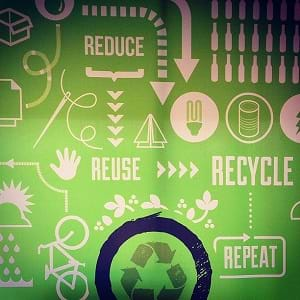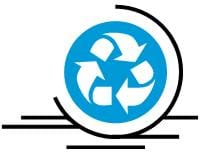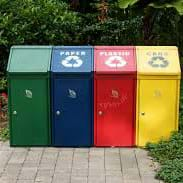
Summary
Students expand their understanding of solid waste management to include the idea of 3RC: reduce, reuse, recycle and compost. They look at the effects of packaging decisions (reducing) and learn about engineering advancements in packaging materials and solid waste management. Through an associated activity, they observe biodegradation in a model landfill (composting).Engineering Connection
Engineers are involved in all steps of integrated-waste management. They use smaller amounts of materials to package products as discussed in the relevant activity It's all In the Package, and use recyclable and reusable materials when possible. Chemical engineers develop environmentally friendly, recyclable materials. Engineers investigate ways to accelerate the decomposition process, develop industrial systems that burn trash for energy at power plants, and design innovative landfills that are more economical and reduce pollution. Have students explore how engineers work with composting in landfills by conducting the associated activity Composting – Nature's Disappearing Act. Then have students explore the third "R", recycling, by conducting the activity Test & Improve: Making Tall & Strong Recycled Towers.
Learning Objectives
After this lesson, students should be able to:
- Explain different methods of waste disposal.
- Explain some of the major problems that waste disposal causes.
- Explain 3RC (reduce, reuse, recycle, compost).
- Describe the different steps involved in integrated waste management.
- Identify ways engineers are involved in 3RC and solid waste management.
Educational Standards
Each TeachEngineering lesson or activity is correlated to one or more K-12 science,
technology, engineering or math (STEM) educational standards.
All 100,000+ K-12 STEM standards covered in TeachEngineering are collected, maintained and packaged by the Achievement Standards Network (ASN),
a project of D2L (www.achievementstandards.org).
In the ASN, standards are hierarchically structured: first by source; e.g., by state; within source by type; e.g., science or mathematics;
within type by subtype, then by grade, etc.
Each TeachEngineering lesson or activity is correlated to one or more K-12 science, technology, engineering or math (STEM) educational standards.
All 100,000+ K-12 STEM standards covered in TeachEngineering are collected, maintained and packaged by the Achievement Standards Network (ASN), a project of D2L (www.achievementstandards.org).
In the ASN, standards are hierarchically structured: first by source; e.g., by state; within source by type; e.g., science or mathematics; within type by subtype, then by grade, etc.
NGSS: Next Generation Science Standards - Science
| NGSS Performance Expectation | ||
|---|---|---|
|
5-ESS3-1. Obtain and combine information about ways individual communities use science ideas to protect the Earth's resources and environment. (Grade 5) Do you agree with this alignment? |
||
| Click to view other curriculum aligned to this Performance Expectation | ||
| This lesson focuses on the following Three Dimensional Learning aspects of NGSS: | ||
| Science & Engineering Practices | Disciplinary Core Ideas | Crosscutting Concepts |
| Obtain and combine information from books and/or other reliable media to explain phenomena or solutions to a design problem. Alignment agreement: | Human activities in agriculture, industry, and everyday life have had major effects on the land, vegetation, streams, ocean, air, and even outer space. But individuals and communities are doing things to help protect Earth's resources and environments. Alignment agreement: | A system can be described in terms of its components and their interactions. Alignment agreement: Science findings are limited to questions that can be answered with empirical evidence.Alignment agreement: |
| NGSS Performance Expectation | ||
|---|---|---|
|
MS-ESS3-3. Apply scientific principles to design a method for monitoring and minimizing a human impact on the environment. (Grades 6 - 8) Do you agree with this alignment? |
||
| Click to view other curriculum aligned to this Performance Expectation | ||
| This lesson focuses on the following Three Dimensional Learning aspects of NGSS: | ||
| Science & Engineering Practices | Disciplinary Core Ideas | Crosscutting Concepts |
| Apply scientific principles to design an object, tool, process or system. Alignment agreement: | Human activities have significantly altered the biosphere, sometimes damaging or destroying natural habitats and causing the extinction of other species. But changes to Earth's environments can have different impacts (negative and positive) for different living things. Alignment agreement: | Relationships can be classified as causal or correlational, and correlation does not necessarily imply causation. Alignment agreement: The uses of technologies and any limitations on their use are driven by individual or societal needs, desires, and values; by the findings of scientific research; and by differences in such factors as climate, natural resources, and economic conditions. Thus technology use varies from region to region and over time.Alignment agreement: |
International Technology and Engineering Educators Association - Technology
-
The use of technology affects the environment in good and bad ways.
(Grades
3 -
5)
More Details
Do you agree with this alignment?
-
Explain why responsible use of technology requires sustainable management of resources.
(Grades
3 -
5)
More Details
Do you agree with this alignment?
State Standards
Colorado - Science
-
Use evidence to develop a scientific explanation about one or more processes that break down and/or combine Earth materials
(Grade
3)
More Details
Do you agree with this alignment?
-
Create and evaluate models of the flow of nonliving components or resources through an ecosystem
(Grade
4)
More Details
Do you agree with this alignment?
Worksheets and Attachments
Visit [www.teachengineering.org/lessons/view/cub_environ_lesson05] to print or download.Introduction/Motivation
Trash... Did you know that people and industry produced more than 292 million tons of waste in 2018, which is more than four pounds of trash per person per day? Wow, that's a lot of garbage!
What are some different ways to dispose of trash? (Brainstorm a list of answers as a class. Expect students to mention landfills and recycling centers, and maybe dumps, trash cans, compost bins, etc. Write student suggestions on the classroom board.)
The most environmentally friendly ways to dispose of trash are to reduce, reuse, recycle and compost. We call these 3RC. These are the first four steps in "integrated waste management." This means that you try to reduce the amount of garbage by the first step (reduce) and with what garbage is left, you venture onto the next step (recycle), and so on, until the garbage or waste is all gone. The key is to have barely any waste left when reaching the last step.
A total of seven steps comprise integrated waste management. (Note: You may want to have an overhead transparency or other classroom copy of the seven steps already prepared and available for reference at this point; see the 7 Steps of Integrated Waste Management Transparency.) In order, the seven steps are: reduce, reuse, recycle, compost, incineration with energy as a result, landfills and incineration with no energy. Engineers are involved at every step of this process. Can you explain how? What might engineers do to make sure that very little waste is being handled by the processes in steps 6 and 7? (Answer: By developing better technologies to help with steps 1-5.) What things might you do to make sure that very little waste is being handled by the processes in steps 6 and 7? (Answer: 3RC: reduce, reuse, recycle and compost.) In this lesson, you will learn more about how engineers help reduce environmental waste and garbage today.

Lesson Background and Concepts for Teachers
No simple, single solution exists to solid waste management. The current thinking is that it should be an integrated, seven-step process, including the 3RC process (the first four steps), incineration (waste-to-energy), landfills and incineration (no energy production). It is ideal to combine the first five of these in such a way as to eliminate — or at least drastically reduce — the amount of waste that has to be dealt with in steps 6 and 7.
7 Steps of Integrated Waste Management
(Steps 1-4 represent the 3RC process discussed in detail in this lesson.)
Step 1 Reduce: As a society, we should make less waste overall. For example, buy items with little or no packaging, use rechargeable batteries, use existing products longer, share items with other people, decide not to purchase an additional car or piece of clothing, etc. Refer to the activity It's all In the Package to have students explore the connection of product packaging and reducing waste.
Step 2 Reuse: We should reuse items we normally throw away. For example, using paper lunch bags multiple times instead of throwing them away after just one use. Refer to the activity Test & Improve: Making Tall & Strong Recycled Towers to challenge students to learn about the power and challenges of using recycled materials.
Step 3 Recycle: We should remember to recycle items that are recyclable (paper and plastic items have a recycling code stamped on them to tell us if they can be recycled). Also, we can "close the recycling loop" by buying items made from and packaged in recycled materials. We must continue looking for new ways to recycle currently non-recyclable items.
Step 4 Compost: We should put our yard waste and food scraps in personal or community compost bins to enrich the soil. Students can use the hands-on introduction activity Composting – Nature's Disappearing Act to learn more about the power of composting.
Step 5 Incineration (waste-to-energy): We should burn trash and use the heat to produce energy for power plants, etc. This should be done on the industrial scale, not at a personal level.
Step 6 Landfills: We should store any leftover waste in a sanitary landfill to reduce the risk to the environment.
Step 7 Incineration (no energy production): We can burn trash just to reduce the amount of space it takes up. This is often done on an individual basis (outside a single home), but it can also be done on an industrial scale. This type of incineration is really the last resort and should be the last thing that we do since it creates and contributes to environmental hazards.
Engineers are involved at every step of this process. This lesson describes their involvement in steps 1-5. Please see Lesson 4 for engineers' involvement in landfill use.
Associated Activities
- It's All in the Package - Students explore the concept of "reducing" solid waste and how this relates to product packaging. They read about and evaluate the highly publicized packaging decisions of two major U.S. corporations. They evaluate different ways to package items to minimize the environmental impact, while considering issues such as cost, availability, attractiveness, etc. Students explore "hydropulping" and consider its use as a recycling process.
- Composting – Nature's Disappearing Act - Students explore the idea of biodegradability by building and observing model landfills. This serves as an introduction to the idea of composting. (Note: This activity can be integrated as an extension of Lesson 4's activity: This Landfill Is a Gas.
- Test & Improve: Making Tall & Strong Recycled Towers - Students learn about material reuse by designing and building the strongest and tallest tower they can, using only recycled materials. They follow design constraints and build their towers to withstand an earthquake and high wind simulations.
Lesson Closure
Review the seven steps of integrated waste management. Ask students to describe one way that they could help with solid waste management in their own homes, schools and communities. Which of the seven steps do their responses relate to? Will they help decrease waste for steps 6 and 7? Challenge the class to reduce the trash that they produce and help one other person reduce his/her trash as well.
Vocabulary/Definitions
3RC: An acronym for reduce, reuse, recycle and compost.
biodegradable: The ability to be broken down by natural environmental processes (involving microorganisms) into basic elements like carbon dioxide, nitrogen and water.
composting: A process in which food, yard and animal wastes decomposes into new soil. Engineers often work to optimize the process so that biodegradation takes place more quickly and efficiently.
hydropulping: A process by which aseptic packages are recycled. Water and agitation separate the packaging layers.
organic: Created from or by living organisms.
recycle: Processing waste and using it as raw material for new products; that is, making trash into something useful instead of just throwing it out. It is often called "resource recovery" because it is actually recovering and reusing natural resources.
reduce: Minimizing the production and consumption of items that are made from new, NOT recycled, materials. Not creating trash in the first place and lessening in amount, number or other quantity (precycling).
reuse: Extending the life of an item by using it again, repairing it, modifying it, or creating new uses for it instead of throwing it away.
Assessment
Pre-Lesson Assessment
Brainstorming: As a class, have students engage in open discussion to brainstorm different ways to dispose of trash. Remind students that in brainstorming, no idea or suggestion is "silly." All ideas should be respectfully heard. Encourage wild ideas and discourage criticism of ideas. Write student suggestions on the classroom board.
Post-Introduction Assessment
Question/Answer: After going through the seven steps of integrated waste management, ask the students and discuss as a class:
- How are engineers involved in each step?
- What might engineers do to make sure that very little waste is being handled by the processes in steps 6 and 7. (Answer: By increasing technologies to help with steps 1-5.)
- What might you do to make sure that very little waste is being handled by the processes in steps 6 and 7? (Answer: 3RC: reduce, reuse, recycle, compost.)
Lesson Summary Assessment
Performance: Teach students the Recycle Now Song, which uses the melody from "Three Bind Mice." Have each student sing a line until every student has had a chance.
Quick Quiz: Ask students to:
- Write down what 3RC stands for. (Answer: Reduce, reuse, recycle, compost.)
- Describe one way you can be involved in 3RC. (Accept all reasonable answers.)
- Describe how an engineer might be involved in one of the 3RC steps.
Homework
Math Assignment: Hand out the 3RC Math Challenge Worksheet as a challenge activity for students. Review the answers during the next class period.
Lesson Extension Activities
Arrange to teach a younger class about recycling (natural and human). Pair each student with a student in a younger class. Have the older students teach the younger students the Recycle Now Song.
Share some of the stories in Recycling (Making a Better World) by Gary Chandler and Devin Graham (published by 21st Century, 1997).
Try using some of the "Recycle City" activities at the EPA website at: https://www3.epa.gov/recyclecity/. Be sure to check out the "Information for Teachers" in the Activities section.
Have students take the "It's not all garbage!" quiz at EEK (Environmental Education for Kids) at http://dnr.wi.gov/org/caer/ce/eek/earth/recycle/notgarbage.htm
Try out some of the activities in "Recycling and Beyond" at http://dnr.wi.gov/org/caer/ce/eek/earth/recycle/index.htm
Check out pictures of Simon Rodia's "garbage sculptures" at http://www.wattstowers.us or from online searches of "Watts Towers." Mr. Rodia spent 33 years creating garbage sculptures, of which some parts are more than 60 feet tall! Ask students what effect they think his efforts had on the surrounding community. How was engineering knowledge useful to him in creating his sculptures? (Note: Encourage students to consider structural and material engineering ideas.) Discuss similar activities in your community.
Invite a local artist/artisan to discuss how they recycle or reuse material in their artwork or profession.
Continue learning about recycling through playing games, taking trivia quiz challenges, doing arts and crafts projects, watching videos and even hearing a new song. Recycling for Kids is filled with fun resources for all these activities and more. You can find this information at: https://www.sciencekids.co.nz/recycling.html. Other resources include a recycling game at https://kids.nationalgeographic.com/games/action-and-adventure/recycle-roundup-new/ and the Kids Super Guide to Recycling at https://www.reusethisbag.com/articles/kids-guide-to-recycling/.
Subscribe
Get the inside scoop on all things TeachEngineering such as new site features, curriculum updates, video releases, and more by signing up for our newsletter!More Curriculum Like This

In this lesson, students learn about the three methods of waste disposal in use by modern communities. They also investigate how engineers design sanitary landfills to prevent leachate from polluting the underlining groundwater.

In this lesson, students explore solid waste and its effects on the environment. They collect classroom trash for analysis and build model landfills in order to understand the process and impact of solid waste management.

By studying key processes in the carbon cycle, such as photosynthesis, composting and anaerobic digestion, students learn how nature and engineers "biorecycle" carbon. Students are exposed to examples of how microbes play many roles in various systems to recycle organic materials and also learn how ...

Where does trash go when it's thrown away? In this unit, students explore solid waste management and the value of 3RC: reduce, reuse, recycle, and compost. Students sort materials as recyclable and non-recyclable as they learn about the processes and pitfalls of landfills. They learn how engineers a...
References
Blashfield, Jean F. and Black, Wallace B. Black. Recycling (SOS Earth Alert). Chicago, IL: Childrens Press, Inc., 1991.
Chandler, Gary and Devin Graham. Recycling (Making a Better World). New York, NY: 21st Century, 1997.
7 Steps to Shrink Your Trash. Department of Natural Resources, Wisconsin. http://dnr.wi.gov/org/caer/ce/eek/earth/recycle/index.htm
An Introduction to the Life, Earth and Physical Sciences. Student Edition, Glencoe Science. Blacklick, OH: Glencoe/McGraw-Hill, 2002.
Sterling, Mary Ellen and Keith Vasconcelles. Thematic Unit – Ecology (Intermediate). Westminster, CA: Teacher Created Materials, Inc., 1991.
EPA. Land, Waste, and Cleanup Topics. 14 July 2020, www.epa.gov/environmental-topics/land-waste-and-cleanup-topics
Woodburn, Judith. Garbage and Recycling. Milwaukee, WI: Gareth Stevens Publishing, 1992.
Copyright
© 2005 by Regents of the University of ColoradoContributors
Amy Kolenbrander; Jessica Todd; Malinda Schaefer Zarske; Janet YowellSupporting Program
Integrated Teaching and Learning Program, College of Engineering, University of Colorado BoulderAcknowledgements
The contents of this digital library curriculum were developed under grants from the Fund for the Improvement of Postsecondary Education (FIPSE), U.S. Department of Education and National Science Foundation (GK-12 grant no. 0338326). However, these contents do not necessarily represent the policies of the Department of Education or National Science Foundation, and you should not assume endorsement by the federal government.
Last modified: November 3, 2021











User Comments & Tips